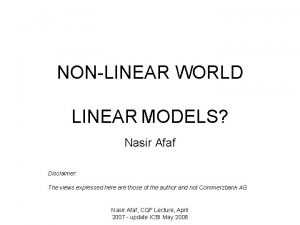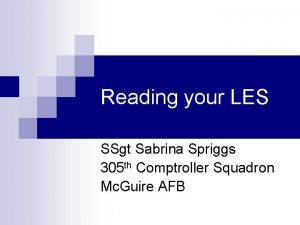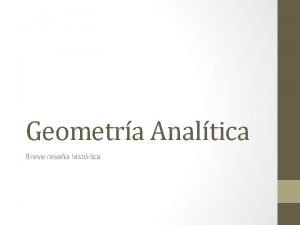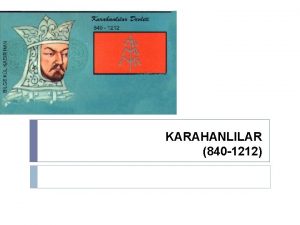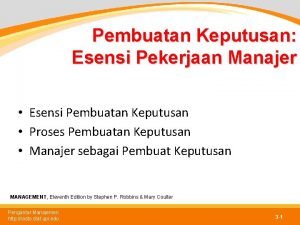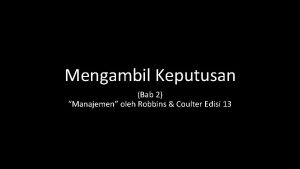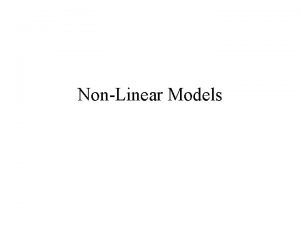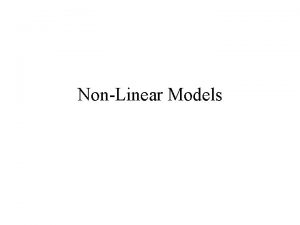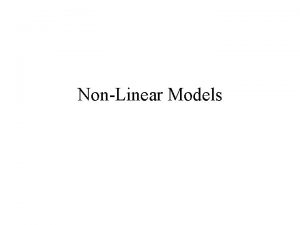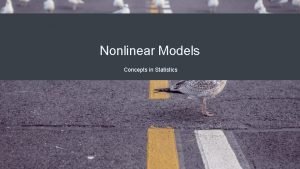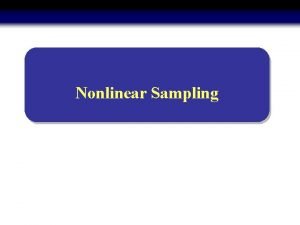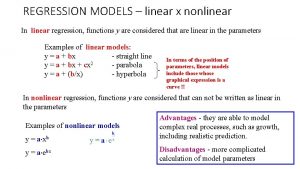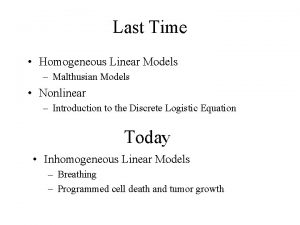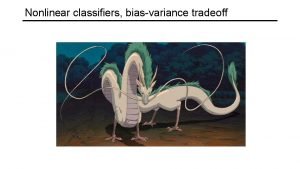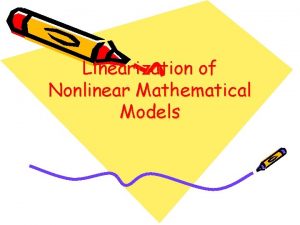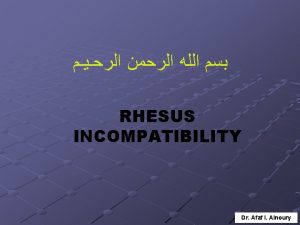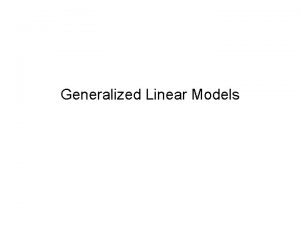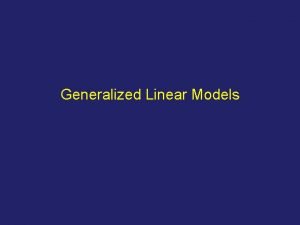NONLINEAR WORLD LINEAR MODELS Nasir Afaf Disclaimer The





















- Slides: 21

NON-LINEAR WORLD LINEAR MODELS? Nasir Afaf Disclaimer: The views expressed here are those of the author and not Commerzbank AG Nasir Afaf, CQF Lecture, April 2007 - update ICBI May 2008

Pyramid of Modern Finance Nasir Afaf, CQF Lecture, April 2007 - update ICBI May 2008

Real Markets • Different classes of market participants • Characterised by different – End objectives – Time horizons – Risk appetite – Response to market dynamics Nasir Afaf, CQF Lecture, April 2007 - update ICBI May 2008

Market Participants • Corporates – hedgers • Market making institutions • Investors: – Hedge funds/Proprietary Trading Desks – Real money managers – asset managers, pension funds etc – CTA’s – Retail Nasir Afaf, CQF Lecture, April 2007 - update ICBI May 2008

Market Participants Behaviour • Equity Smile Example – Equity Skew for downside is systematic risk premium for investors holding primarily long positions. Equity Sell off would trigger stop losses, and a quick down move. Therefore premium for downside puts – Skew stays bid for downside even if equity markets trend upward, so not a statistical predictor of future moves, rather a descriptor of pain thresholds Nasir Afaf, CQF Lecture, April 2007 - update ICBI May 2008

Market Participants Behaviour • FX “Carry” Smile example – – – “Carry” traders look to earn higher yield through borrowing in low interest rate economies and depositing in higher interest rate economies. Example EUR/TRY, with a 1 y rate differential of 15% (1500 bp) “Carry” traders carry risk that the higher yielding currency weakens – therefore risk reversals (skew) systematically bid for strong currency calls (puts on the higher yielding currency) As systematic as Equity Skew. USD/JPY is the biggest example Nasir Afaf, CQF Lecture, April 2007 - update ICBI May 2008

Market Participants Behaviour • Equity and FX Skew Direction Comparison – – On a statistical examination Equity and FX markets appear very different. Opposite directions of skew as compared to Forward points. But misleading. Understanding of both markets shows that same dynamics give rise to opposing skews. Both markets willing to pay a premium for getting out of their long positions Equity investors look to make money through capital appreciation from long equity positions. Their “pain” is a sell off in equities – hence willing to pay for downside protection. FX investors look to make money through “carry”. Their “pain” is a weakening of the higher yielding currency – hence willing to pay for upside protection. Nasir Afaf, CQF Lecture, April 2007 - update ICBI May 2008

Markets are non-linear – the weak part • • Interaction amongst market participants is key. He (unknown) did this, so I do that…. . To understand how that interaction occurs you have to understand each type of participant. For example, asset managers do not adjust their holdings frequently. Certain types of hedge funds may do (“Renaissance”? ) This gives rise to price dynamics in short term. Nasir Afaf, CQF Lecture, April 2007 - update ICBI May 2008

Markets are non-linear – the strong part • • • Interaction is played out against a backdrop of liquidity, credit lines, levels of permitted risk, introduction of new financial instruments This generates price dynamics. Perfectly random to a pure statistician with no insight into what constitutes a market. Structured randomness for an insightful market participant. Information and insight is the key. Resulting price dynamics strongly feed back into liquidity, credit lines, levels of permitted risk, introduction of new financial instruments. This never ending feedback loop is what we call a market. Nasir Afaf, CQF Lecture, April 2007 - update ICBI May 2008

Using Derivatives Models • • Model first, or think first Linear SDE etc… Linear models highly idealised – though useful. Easiest to model. Real pricing is non-linear. Price can never be independent of risk limits, and the risk in your book. You always have to make mental adjustments. Nasir Afaf, CQF Lecture, April 2007 - update ICBI May 2008

So who is a Derivatives Trader • • Linear model Non-linear markets with feedback effects Non-linear pricing with respect to mental adjustments to account for risk in book, and risk limits etc A derivatives trader is a non-linear control hired by the bank to trade non linear instruments valued using linear models. This non-linear control is generally far from optimal! Nasir Afaf, CQF Lecture, April 2007 - update ICBI May 2008

Ingredients in non-linear control • Specific – Mkt risk limits – Credit limits – Performance year to date! – Current book profile – Availability (and understanding!) of “useful models” Nasir Afaf, CQF Lecture, April 2007 - update ICBI May 2008

Ingredients in non-linear control • General (Market Specific) – Regulatory framework – Liquidity (Depth of market) – Transaction costs – Aggregate “market maker” positioning Nasir Afaf, CQF Lecture, April 2007 - update ICBI May 2008

Missing ingredient in models • Liquidity – Derivatives Models assume an infinite sea of liquidity – Economic concepts of liquidity? – My concept of liquidity: All price changes are due to the ebb and flow of liquidity. It is only meaningful to speak of liquidity at a certain price level and at a certain time. Every price movement is a liquidity squeeze. Nasir Afaf, CQF Lecture, April 2007 - update ICBI May 2008

Feedback effects • Feedback – Derivatives Models (“no arbitrage”) valuations are based on hedging recipes – Superiority of a model based on how well “recipe” can be executed in practise – Can divide products/models into different classes. Easy to hedge recipe (“fwd”), difficult to hedge recipe (“short date digital”). – Market risk aggregation due to popularity of products/ideas/structures. Nasir Afaf, CQF Lecture, April 2007 - update ICBI May 2008

Feedback from derivatives “recipes” into liquidity • Pyramid of modern finance (slide 1). Not so one way! • Each popular product creates its own feedback • Ever changing nature of liquidity, creates new opportunities, and more products • Sometimes best way to trade cash is to be on top of complex exotics (“know the top of the pyramid, trade the base”) Nasir Afaf, CQF Lecture, April 2007 - update ICBI May 2008

Modeling liquidity - 1 • Tangible Inputs – Tangibles (available to all) • • Bid-offer spreads in market Volatility levels and other such information “Sea” of all available market data “Theory of everything model” or specific “phenomenological model” from observable market data. Trade-offs between model choices. Nasir Afaf, CQF Lecture, April 2007 - update ICBI May 2008

Modeling liquidity - 2 • Intangibles – Effective “information set” and analysis – Modelling “interaction” – Modelling non-linear feedback – Distinction between market-makers and market takers. Claim: over emphasised. Market makers are often market takers. “Inventory management” is best analogy for market making activity. Nasir Afaf, CQF Lecture, April 2007 - update ICBI May 2008

Successful liquidity modelling • Any reasonable liquidity model (understanding) must be dynamic rather than static. • Be able to explain some phenomenon not amenable to traditional approaches (“wisdom” rather than “proof”) • Must then imply a dynamical statement for price dynamics – and produce observed “statistical signatures” • As in “chess” feedback and adaptive responses, tactical and strategic, must appear. These are subjective ingredients. Nasir Afaf, CQF Lecture, April 2007 - update ICBI May 2008

What it comes down to • Derivatives valuations cannot be expected to be unique. • Different “information set”, different “subjective analysis of interaction”, different “strategy”, for each participant is key. • Traders attempt to “control” this nonlinearity heuristically. At least the thoughtful (successful? ) ones do! Nasir Afaf, CQF Lecture, April 2007 - update ICBI May 2008

What it comes down to – BIG PICTURE • All comes down to “predicting” and modeling Order Flow. • Order Flow is driven by liquidity dynamics, which then translates into price changes. • Shorter term as opposed to longer term positioning. • Modeling becomes “Cause and Effect” rather than “Blind Statistical descriptions” Nasir Afaf, CQF Lecture, April 2007 - update ICBI May 2008
 Nasir afaf finance
Nasir afaf finance Afaf haddad
Afaf haddad Ytd entitle
Ytd entitle Kurşun subasetat çözeltisi
Kurşun subasetat çözeltisi Dr adeel
Dr adeel Nasir kassamali
Nasir kassamali Adeel nasir
Adeel nasir Subacute combined degeneration of the cord
Subacute combined degeneration of the cord Ustaz nasri nasir
Ustaz nasri nasir Lovachevsky
Lovachevsky Samuel nasir
Samuel nasir Böritigin i. ahmed
Böritigin i. ahmed Linear and nonlinear data structure
Linear and nonlinear data structure Nonlinear video editing
Nonlinear video editing Linear and nonlinear data structure
Linear and nonlinear data structure Example of linear text
Example of linear text Contoh gaya berpikir linear dan nonlinear
Contoh gaya berpikir linear dan nonlinear Linear plot structure
Linear plot structure Non linear pharmacokinetics definition
Non linear pharmacokinetics definition Linear or nonlinear
Linear or nonlinear Contoh gaya berpikir linear
Contoh gaya berpikir linear Reservation table in pipeline
Reservation table in pipeline
